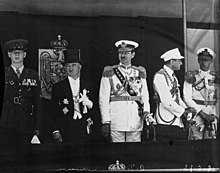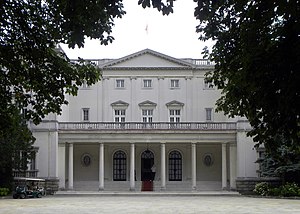Prince Paul of Yugoslavia
[6] A cultured and easy-going bon vivant who inspired much affection from his friends, Paul when not associating with the British aristocracy collected paintings by Monet, Titian and van Gogh.[5] Despite the fact that it was Austria-Hungary that declared war on Serbia on 28 July 1914, Paul only joined the Royal Serbian Army in November 1914, serving for six months before returning to Britain in May 1915.[8] Paul found his palace at Dedinje to be gloomy, causing him to relocate to a villa in Slovenia, where he felt more at home, and where he took up his time with his ever expanding art collection and raising his family.[12] The three men opened up the safe that contained the royal will whose terms stated that Paul was to serve as the regent until the new king Peter II came of age in September 1941.In its broadest outline, his domestic policy worked to eliminate the heritage of the Alexandrine dictatorship's centralism, censorship, and military control, and to pacify the country by solving the Serb-Croat problem.[13] Paul wanted to achieve a Serb-Croat reconciliation, but also felt for a considerable period of time that he had the duty to hand over the kingdom to Peter more or less unchanged when he reached his maturity, and thus was unwilling to entertain constitutional changes.[14] A French diplomat described Paul as a man whose "incontestable qualities of character, balance, and taste... Oxonian dilettantism and charm, which he exercised on his visitors, were useless in the present circumstances and in a country where arguments of might are the only ones which count".[20] On 24 June 1935, Paul appointed Milan Stojadinović as prime minister, with a mandate to deal with the Great Depression and find a solution to the "Croat question".[21] Stojadinović believed that the solution to the Great Depression were closer economic ties with Germany, which had more people than what it could feed and lacked many of the raw materials necessary for a modern industrial economy.[27] The agreements with Italy very much alarmed the French who sent out General Maurice Gamelin to visit Belgrade in September 1937, followed by the Foreign Minister Yvon Delbos in December 1937, who in both cases sought reassurances that Yugoslavia was not abandoning its alliance with France.When President Edvard Beneš of Czechoslovakia visited Belgrade, he was greeted by enthusiastic crowds cheering him, which was seen as a sign that public opinion was still attached to the traditional alliances.[28] At a Little Entente summit at King Carol II's summer residence at Sinaia in August 1937, Paul and Stojadinović pressed Beneš to end Czechoslovakia's alliance with the Soviet Union, complaining it upset the Germans too much.[29] Terence Shone, the first secretary at the British legation in Belgrade reported that Serbian public opinion was very pro-Czechoslovak and expected Yugoslavia to go to war if its ally were attacked.[34] On 15 March 1939, Germany occupied the Czech half of the rump state of Czecho-Slovakia (as Czechoslovakia had been renamed in October 1938), turning it into the Protectorate of Bohemia and Moravia.[35] The fact that the Reich extinguished the independence of Czecho-Slovakia despite the way in which Emil Hácha and the rest of the leaders had endeavoured to carry out a slavishly pro-German foreign policy, came as a considerable shock to Paul.[38] After Germany and Italy, Hungary was the nation that Paul worried about the most as he noted that Danube river valley ran down from the Hungarian plain straight to Belgrade.[39] While he was in Germany, Paul dispatched General Petar Pešić on a secret mission to Paris and London to find out what were the Anglo-French plans in the event of a war.[41] Pešić found that the French, who preferred that fighting take place anywhere but France, were far more interested in having Yugoslavia enter the conflict if the Danzig Crisis led to a war than were the British.[41] From Gamelin, he learned the French were already planning on having the Army of the Levant commanded by Maxime Weygand land at Thessaloniki to march up the Balkans to link up with the Yugoslavs and the Romanians to aid the Poles.[42] The same month, when Romanian Foreign Minister Grigore Gafencu visited Belgrade, Paul spoke to him of his wish for both Yugoslavia and Romania to have closer ties with Britain.[41] As the Danzig Crisis pushed Europe to the brink of war, Vladko Maček of the Croatian Peasant Party became convinced of the necessity of "throwing a bridge across the abyss which separated Serb from Croat".[48] The sporazum (agreement) granted broad autonomy to Croatia, and partitioned Bosnia and Herzegovina as the government agreed to Maček's demand for all of the Croats in Yugoslavia to live under the authority of the Croatian banovina.[47] On 26 August 1939, as the Danzig Crisis moved towards its climax, Paul, in a letter to Lord Halifax, once again urged that Britain launch a "preemptive war" against Italy if Germany invaded Poland.[45] Paul warned if Germany conquered Poland, Italy would sooner or later enter the war, and if that happened, the Italian forces in Albania with support from Bulgaria would be used to threaten the other Balkan states.[50] The news of the Ribbentrop-Molotov Pact was an especially bitter blow for Paul, as it ensured that the two strongest powers in Eastern Europe would be working together, and it ended the regent's hopes of an Anglo-French alliance, which might finally rid Yugoslavia of the constant Italian efforts to undermine national unity.[52] Paul repeatedly pressed for a revival of the Salonika Front strategy of First World War by arguing that if French and British forces landed at Thessaloniki, which would place them in a position to aid Yugoslavia, he might lean more towards the Allies.On 27 March 1941, two days after Yugoslavia had signed the Tripartite Pact, Yugoslav military figures with British support forcibly removed Paul from power and declared King Peter II of age.Prince Paul was rehabilitated by the Serbian courts in 2011 and on 6 October 2012 was reburied at the family crypt of Oplenac, near Topola in central Serbia, together with his wife Olga and son Nikola.[63] Princess Elizabeth, his only daughter, obtained information from the British Special Operations Executive files in the Foreign Office in London and published them in Belgrade in the 1990 edition of the Serbian-language biography of her father."[1] Prince Paul, together with King Alexander I of Yugoslavia, collected, donated and dedicated a large number of art works to Serbia and the Serbian people, including foreign masterpieces.







Prince regent of YugoslaviaPeter IISaint PetersburgRussian EmpireBois-de-Vaux CemeteryLausanneSt. George's Church, OplenacPrincess Olga of Greece and DenmarkPrince AlexanderPrince NicholasPrincess ElizabethKarađorđevićPrince Arsen of YugoslaviaAurora Pavlovna DemidovaKingdom of SerbiaKingdom of YugoslaviaArmy GeneralCavalryReference styleHis Royal HighnessSerbo-Croatianromanizedprince regentAlexander IArsen of SerbiaPeter ISwedish speaking FinnishAurora KaramzinPavel Nikolaievich DemidovPeter TroubetzkoyElisabeth EsperovnaBelosselsky-BelozerskyHouse of KarađorđevićSerbiaHouse of ObrenovićAlexanderUniversity of OxfordChrist Church, OxfordBullingdon ClubPrince George, Duke of KentHenry ChannonLord GageTitianvan GoghAustria-HungaryRoyal Serbian ArmyGreecePrincess Marina, Duchess of KentDuke of YorkGeorge VIBelgradeVidovdan ConstitutionDedinjeVlado ChernozemskiAlexander I of YugoslaviaMarseilleFranceregentNikola UzunovićPetar ŽivkovićYugoslav rather than SerbAlexandrine dictatorship'sAnglophileHellenophileFascist ItalyNazi GermanyWorld War Ialliance with Franceheaviest lossesHungaryAnte PavelićPierre LavalMilan StojadinovićGreat Depression"Croat question"Rhinelandoccupied by FranceGerhard WeinbergTreaty of Versaillesremilitarization of the RhinelandWest WallLittle EntenteRomaniaCzechoslovakiaBucharestSoviet UnionHoare–Laval Pact"Gentlemen's Agreement" of 1937Easter AccordsRonald CampbellMaurice GamelinYvon DelbosEdvard BenešCarol IISinaiaSudetenlandTerence ShoneMunich AgreementEdward OkuńGaleazzo CianoYugoslav Radical UnionAlbaniaskupshtinaGermany occupiedCzecho-SlovakiaProtectorate of Bohemia and MoraviaEmil HáchaItalians annexed AlbaniaBalkan PactTurkeyStrait of OtrantoBalkansCarol II of RomaniaPrince Nicholas of RomaniaŞükrü SaracoğluBulgariaDobrujaBoris III of BulgariaVictor Emmanuel III of ItalyGreekscolony of AlbaniaHungariansBerlinRaymond BrugèreBank SeligmannYugoslav military
